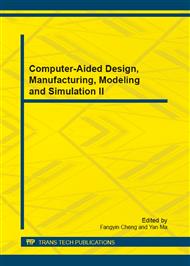p.235
p.241
p.246
p.251
p.257
p.262
p.268
p.273
p.279
Simulation of the Space Turntable Angular Velocity Measurement
Abstract:
For better design and control of the space turntable, a model for measuring its angular velocity was built. The model utilized a two-axis space turntable to perform the simulation basing on the coordinate conversion theory. The measuring simulation went on with the help of MATLAB software using different carrier attitude angles. It shows the maximal error in the sub astral point longitude and/or latitude is 0.00785 degrees when comparing with the STK results, certifying the validity of the models. The satellite attitude angles have influence on the angular velocity, the maximal azimuth angular velocity is 3.784 deg per sec, yet the elevation's is 0.6945 deg per sec when the attitude angles are all 20 degrees. This simulation process provides some guidance for designing, controlling and calibrating the space turntable.
Info:
Periodical:
Pages:
257-261
Citation:
Online since:
December 2012
Authors:
Price:
Сopyright:
© 2013 Trans Tech Publications Ltd. All Rights Reserved
Share:
Citation:


